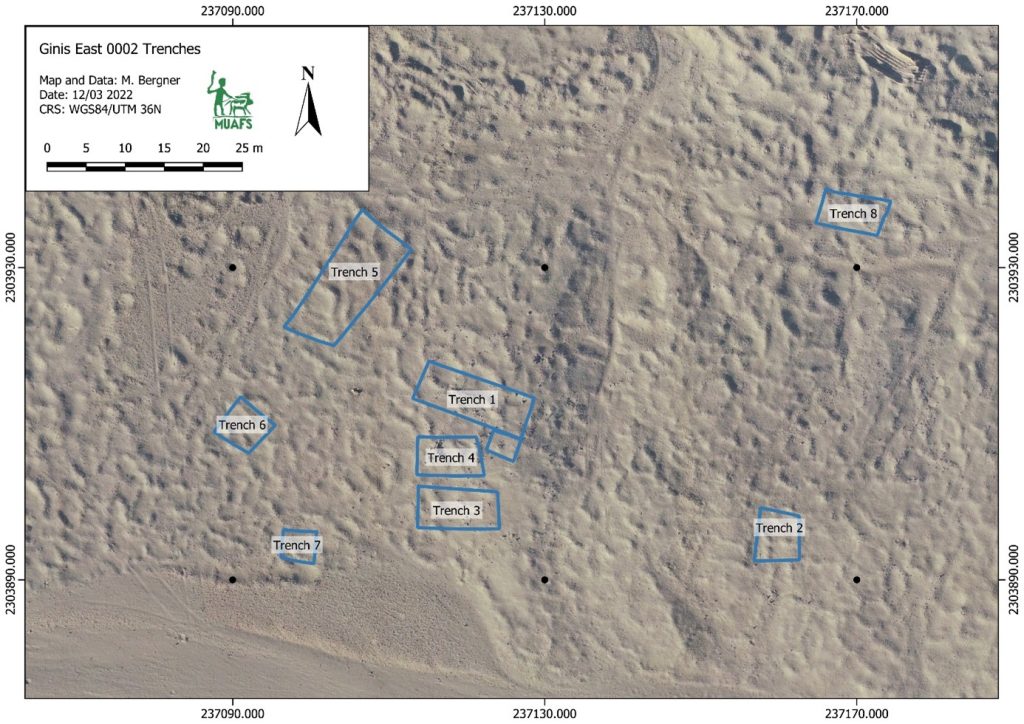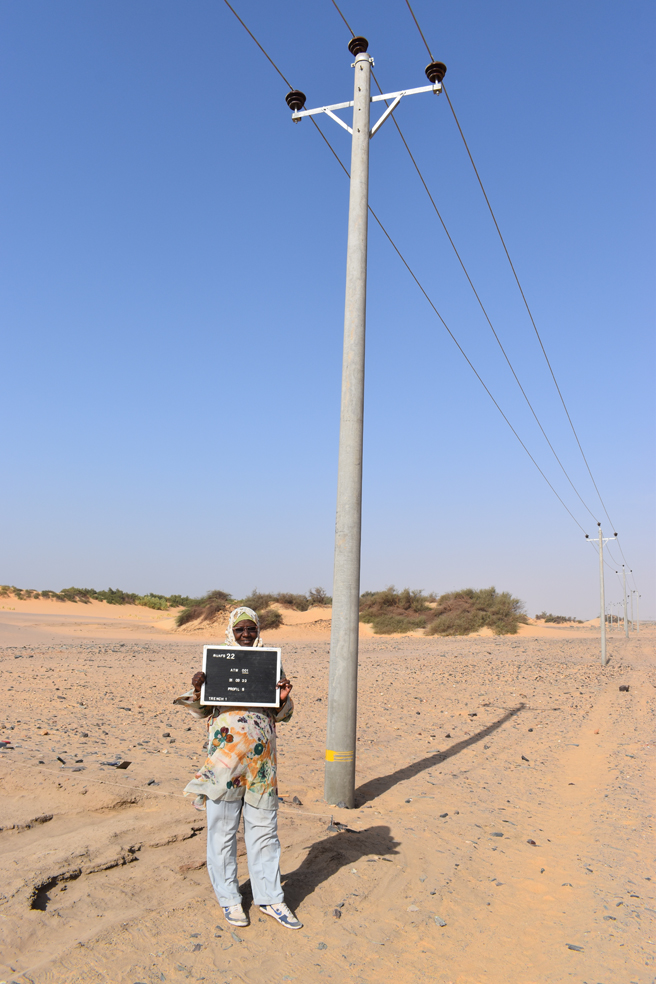It seems already like ages ago that we left Sudan in mid-April! Here in Munich, all is very busy with the start of the summer term and loads of administrative things. Thus it was a bit silent here on the blog.
With the weekend approaching, it’s time for at least a short summary of our successful spring 2022 season. We collected loads of data which will keep us busy in the next months – I am especially delighted that we were able to excavate cemeteries and also a domestic site. This is perfectly in line with our integrated approach combining funerary and domestic archaeology in the study of the contact space biography of the Attab to Ferka region in northern Sudan.
In our first excavation season with local workmen – who did a great job under the supervision of Rais Ramy – we focused on what was classified as Bronze Age sites in the area of Ginis and Attab.

GiE 001 – surface traces of occupation
In the first week of the 2022 season, we worked at GiE 001. Recorded by Vila as 2-T-36B, this domestic site at Ginis East has been assigned to the Egyptian New Kingdom, showing also an intriguing Kerma presence according to the surface finds as well as some Napatan sherds and Christian material. As a follow up to test excavations in 2020, two trenches were excavated to check the sedimentation. Both new trenches in GiE 001 confirm now that there simply is a thin sandy surface layer with much pottery and other finds like stone tools on top of natural alluvial deposits, without any anthropogen remains in the soil. This corresponds to the results from two test trenches in 2020 (Trench 1 and 2, Budka 2020, 66-67). As disappointing as this may sound for something we were hoping to excavate as a New Kingdom settlement site, it is really important for our understanding of site formation processes in the region.
GiE 002 – a small-scale cemetery
Much more successful were the excavations in cemetery GiE 002. Here, the main aim was to check the dating to the New Kingdom as proposed by Vila in the 1970s. We opened a total of eight trenches and one small extension and only discovered two tombs of the pit burial type as described by Vila. All the associated ceramics seem to postdate the New Kingdom respectively start in the very Late New Kingdom.

The most interesting burial was Feature 2 in Trench 4 – I already described in an earlier blog post the intriguing long use-life of this tomb.
In the main pit of Feature 2, remains of seemingly original burials were unearthed below the intrusive Medieval burial which was found wrapped in textiles. A minimum of two individuals were found associated with Pre-Napatan/Napatan pottery, including a complete Marl clay vessel.

Finally, the oldest burial of Feature 2 was discovered in an extended position in the southern niche of the tomb. It was partly moved during the looting in antiquity but is otherwise complete. With remains of mud bricks which were formerly blocking the niche, this tomb finds close parallels in Missimina (Vila 1980), also as far as the material culture is concerned.
In conclusion, GiE 002 proved to be of more complex character than assumed by Vila – not only simple pit burials were executed on this cemetery, but also pits with side chambers and with mud brick blockings. The date as proposed by Vila needs to be corrected: this small cemetery post-dates the New Kingdom and flourished in the 10th-8th centuries BCE.
GiE003 – a substantial Kerma cemetery
The richest excavation site of the 2022 season was the Kerma cemetery GiE 003 (Vila’s site 2-T-39). It is a large cemetery with an estimate of 150 tombs in an area of 200x100m. We opened two trenches and were lucky enough to be able to show a chronological development. Despite of ancient looting, some of the Kerma burials were nicely preserved and datable by means of finds. A total of 28 pits was excavated. With our Trench 2 in the southern part of the cemetery, we cleaned part of the cemetery which shows large circular pits of the Middle Kerma period.

In Trench 1 further north, we had mostly rectangular pits, all with depressions on the east and west end for funerary beds, which can be nicely dated to the Classical Kerma period.

In general, GiE 003 finds a very close parallel in the cemetery of Ukma in the Second Cataract region (Vila 1987). At our site, the wooden funerary beds are not as nicely preserved and the burials more disturbed, but the pottery is very similar as are pieces of jewelry like beads and other objects.
The Kerma cemetery GiE 003 will be the subject of several future blog posts – Rennan Lemos was responsible for the find documentation and I processed all the ceramics. The results are interesting on various levels. Overall, the burials suggest a certain wealth of the Kerma communities who were living in Attab and Ginis and chose GiE 003 as their last resting place.
AtW 001 – first glimpses on New Kingdom settlement activities on the west bank
Finally, we had stunning results at Attab West at a domestic site we labelled AtW 001. Domestic rubbish deposits from the early 18th Dynasty but also the evidence of overfired ceramics, red bricks and at least one kiln highlight the huge potential of this part of our concession for a variety of research questions. Furthermore, the site is located just next to the new line of electricity poles – and was partly disturbed by this modern construction. In general, there is the urgent need for excavations in the area, especially on the west bank.

Altogether, the 2022 excavation season of the DiverseNile project within the framework of the MUAFS project enables us to approach previously little-known cemeteries but also domestic sites with new ideas. Our work resulted in an advanced level of understanding chronological patterns and social implications connected with Kerma and New Kingdom remains in the region and will serve as the basis for future studies.
References
Budka 2020 = J. Budka, Kerma presence at Ginis East: the 2020 season of the Munich University Attab to Ferka Survey Project, Sudan & Nubia 24, 2020, 57-71.
Vila 1980 = A. Vila, La prospection archéologique de la Vallée du Nil, au Sud de la Cataracte de Dal (Nubie Soudanaise). Fascicule 12: La nécropole de Missiminia. I. Les sépultures napatéennes. Paris 1980.
Vila 1987 = A. Vila, Le cimetière Kermaique d’Ukma Ouest. Paris.
